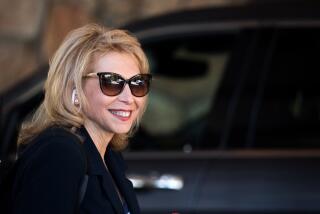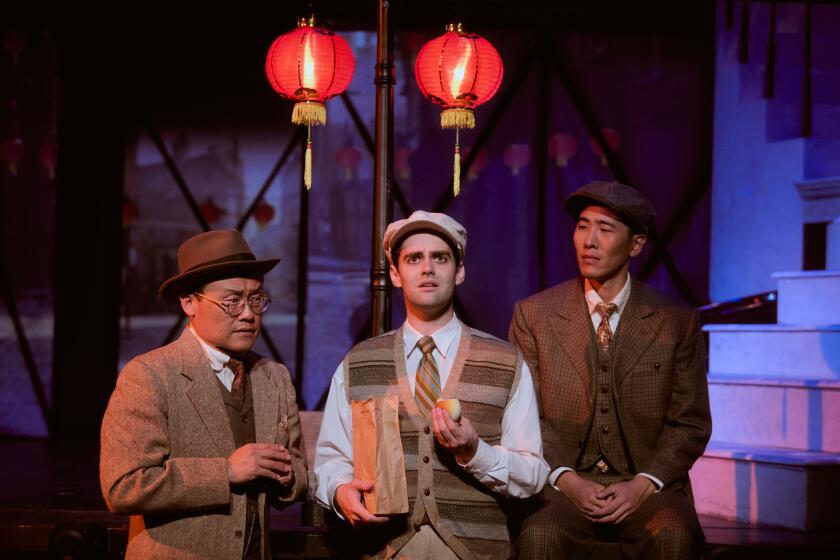DUKE ELLINGTON STAMP: A TRIBUTE THAT STICKS
Tuesday was a day of celebration for the Ellington People. There were five events spread across the day to herald the issuing--on what would have been Duke Ellington’s 87th birthday--of a commemorative 22-cent postage stamp.
The jubilation began in the morning at St. Peter’s Lutheran Church in midtown. All the right dignitaries were on hand: the Rev. John Gensel of St. Peter’s, who has done more for the morale and support of jazz musicians than any other man of the cloth; representatives of the U.S. Postal Service and officials of the international Duke Ellington Society, whose dogged lobbying since 1982 had produced more than 50,000 letters to the Postal Service requesting the stamp. It could not have been done much earlier, because commemorative stamps of civilians are never issued until 10 years after the subject’s death (Ellington died on May 24, 1974).
It was a family affair in every sense. Ruth Ellington Boatwright spoke about her brother’s faith and thanked God and the Ellington Society, in that order, for bringing this day about. Her husband, classical singer McHenry Boatwright, sang the national anthem. Mercer Ellington, who took over the orchestra on his father’s death, conducted it in an old Ellington work newly retitled “22-Cent Stomp,” and in another of the maestro’s lesser-known works, “Afrique.” Concerning the latter, he remarked: “We were the forerunners of the Post Office--first came the jungle telegraph.”
There were countless links to past Ellingtonian glories. Singer Anita Moore and a few other band members are holdovers from the ducal days. On hand, too, were the four Ellington grandchildren, many former sidemen (among them trombonist Father John Sanders, who gave up the jazz world for the priesthood) and numerous women of various ages, each of whom doubtless believes she was the only woman the Duke really loved.
After the St. Peter’s ceremony, members of the Ellington Society stayed over for a two-hour jam session. Mercer took off for Roosevelt Hospital to give the inaugural speech for the opening of the new Duke Ellington Cancer Center for the Performing Arts (Ellington was a cancer victim).
Next came a cocktail party at the headquarters of the American Society of Composers, Authors and Publishers, held amid a babble of songwriters, elderly Ellington groupies and visiting West Coasters such as John (“Body and Soul”) Green. With Mercer were his daughters, Gaye, a painter, and Mercedes, a dancer who has her own company, Ballet Tap USA.
This dance group was one of two (the other an Alvin Ailey ensemble) presented at the day’s final affair, primarily a rerun of some of Duke Ellington’s Sacred Concert material at the cathedral of St. John the Divine, with Billy Taylor, pianist and educator, conducting an orchestra and with Douglas Fairbanks Jr., whose narration was stronger on diction than conviction. But he was reading Duke’s words, and for many of us it was hard to forget the unique and compelling narrative style of the master.
The history of Ellington’s sacred music goes back to 1965 and San Francisco’s Grace Cathedral. In most of these houses of worship the music may be sacred but the acoustics are profane. Some of the singers, notably the operatic stylist Priscilla Baskerville, rose above the resonance on this occasion. Others, such as the splendid gospel artist Esther Marrow, were engulfed by it.
Whatever the minor musical mishaps, there was an overriding sense of joy throughout this day. As the former Ellington vocalist Joya Sherrill said, clutching her first-day-of-issue stamped envelope, “If somebody had told me, when I sang in the band, that I’d see Duke on a stamp, I’d have said they were crazy. But things have really changed a bit since 1945.”
More to Read
The biggest entertainment stories
Get our big stories about Hollywood, film, television, music, arts, culture and more right in your inbox as soon as they publish.
You may occasionally receive promotional content from the Los Angeles Times.






